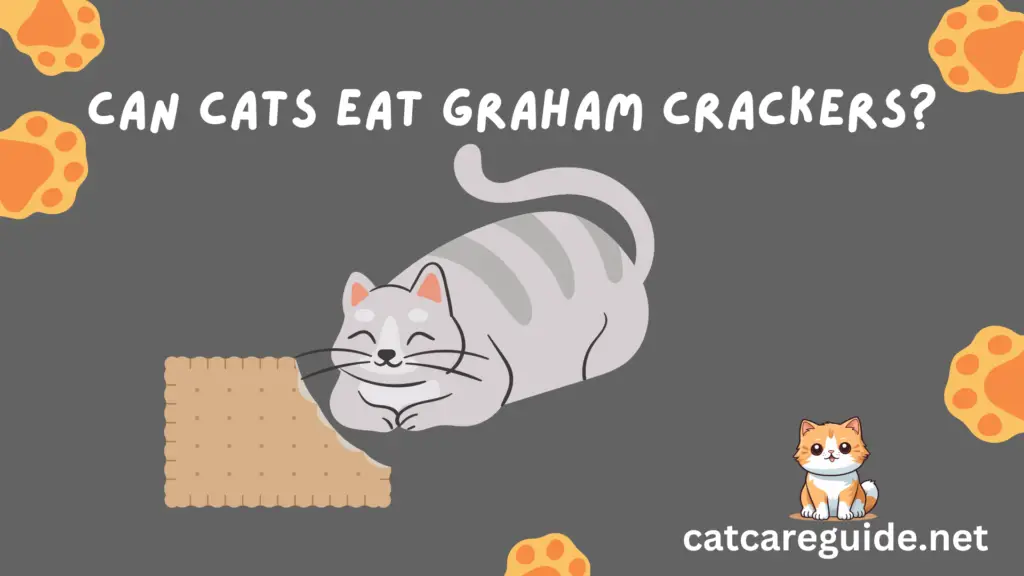
Have you ever wondered if you can share your Graham crackers with your feline friend?🐾 As cat owners, it’s natural to want to spoil our furry companions and give them a small bite of our snacks.
Graham crackers may seem harmless. But are these sweet, crunchy treats safe and healthy for cats?
Cats are obligate carnivores, which means their diet should primarily consist of meat. While Graham crackers aren’t toxic to cats, they don’t provide any nutritional value for them. Graham crackers are high in sugar and carbohydrates, which are not beneficial for cats and can lead to obesity and other health issues if consumed in large amounts.
It’s always best to feed your cat a balanced diet designed for their specific nutritional needs, and treats should not make up more than 10% of their daily caloric intake. If you’re considering giving your cat a new type of food or treat, it’s always a good idea to consult with your vet first.
In this article, we’ll dive into everything you need to know about feeding graham crackers to cats. We’ll cover:
- Are Graham crackers toxic to cats?
- Nutritional content: What’s actually in Graham crackers?
- Benefits and risks of giving graham crackers to cats
- How much Graham cracker can cats eat?
- Healthier cat snack alternatives to graham crackers
- And more…
Let’s start by answering the important question of whether Graham crackers are toxic and safe for cats.
Table of Contents
Are Graham Crackers Toxic or Dangerous for Cats?
The good news is that Graham crackers are not toxic, poisonous, or inherently dangerous for cats, according to the ASPCA Poison Control Center.
Graham crackers are not made with anything toxic, like xylitol or chocolate, that can harm cats.
So, Graham crackers are non-toxic and generally safe for cats from a poisoning standpoint. But that doesn’t necessarily mean they are a healthy, regular snack for cats…
While Graham crackers won’t poison cats, they provide little nutritional value. Ingredients like sugar, carbs, and calories can cause issues if overfed. We’ll explain more shortly.
First, look at what’s in the Graham crackers that make up this sweet treat.
Graham Cracker Ingredients and Nutritional Value
Before feeding any human snacks to your cat, it’s important to analyze the ingredients and nutritional makeup.
This tells us how Graham crackers may impact feline health and whether they align with a cat’s dietary needs.
Here is the typical ingredient list found in Graham crackers:
- Unbleached, enriched flour (wheat flour, niacin, reduced iron, thiamine mononitrate, riboflavin, and folic acid)
- Whole grain wheat flour
- Sugar
- Canola oil
- Honey
- Baking soda
- Salt
- Soy lecithin
- Cinnamon
- Molasses
As you can see, the main ingredients are flour, sugar, honey,, and molasses. This gives graham crackers their sweet taste and crunchy-soft texture.
But when we look closer at the nutritional content per serving, Graham crackers are high in:
- Carbohydrates
- Sugar
- Calories
- Fat
And they contain little:
- Protein
- Fiber
- Essential vitamins and minerals cats need
Graham crackers are not balanced and nutritionally dense snacks designed for a cat’s dietary requirements.
So what does this mean for cats?🤷♂️
While the ingredients look harmless, the high carb, sugar, and calorie content combined with low protein and nutrients can negatively impact cats if overfed with Graham crackers.
Next, let’s dive deeper into the possible benefits and risks of feeding your cat Graham crackers so you can make an informed decision.
Potential Benefits of Feeding Cats Graham Crackers
Are there any potential benefits of occasionally treating your cat to these sweet crackers?
Here are a few possible perks:
Provides Variety in Flavor and Texture
Adding a few tiny pieces of Graham cracker to your cat’s regular kibble or wet food can provide a nice change of pace.
The sweet honey taste and crunchy-soft texture give their palette something different from the usual cat food flavors and textures. This variety and novelty may be exciting and satisfying for some cats.
Source of Temporary Happiness
Some cats may genuinely enjoy munching on a bite-sized bit of Graham cracker if given very sparingly as a special snack. It can be a nice surprise treat that makes them happy for a short time.
As pet owners, seeing our cats happily eat a snack with gusto can provide us happiness too. The key is keeping treats limited so they remain special.
So while Graham crackers likely don’t provide major nutritional benefits, the flavor novelty and your cat’s temporary enjoyment can be nice perks.
However, there are also some potential downsides to be aware of before freely giving your cat Graham crackers. Let’s explore those next.
Potential Risks of Feeding Cats Graham Crackers
While an occasional tiny crumb may be fine, regularly feeding larger amounts of Graham crackers to cats can pose some risks.
Weight Gain and Obesity
With 130 calories per 31-gram serving, Graham crackers are very high in calories relative to their low nutrient and fiber content.
It’s easy to overfeed calories from such energy-dense treats, which can lead to weight gain, especially in cats prone to obesity. Excess weight stresses joints and vital organs and leads to diabetes.
Nutritional Imbalances
Too many graham crackers in place of foods designed for feline health can lead to imbalanced nutrition deficient in protein, vitamins, and minerals cats need to thrive.
This can cause a host of health issues over time.
Upset Stomach, Diarrhea, or Constipation
Too many Graham crackers for some cats may cause indigestion, diarrhea, or constipation when their digestive system tries processing the high carbs, sugar, fat, and calories.
Tooth Decay
The sugar content also risks eroding tooth enamel and promoting cavities in cats if given too frequently over time. Dental issues are painful and costly.
As you can see, regularly providing too many Graham crackers to cats in place of balanced cat food can cause harm over time, despite being non-toxic.
Moderation and balance is key when it comes to human food treats. So how much is safe?
How Much Graham Cracker Can Cats Eat? Feeding Guidelines
The experts at the ASPCA recommend limiting treats for cats to no more than 10% of their daily caloric intake to prevent obesity and health issues.
For a 10 pound cat consuming about 240 calories daily, 10% would equal just 24 treat calories per day.
Considering graham crackers contain about 130 calories per 31 gram serving, feeding more than a few tiny crumbled bits exceeding 1-2 grams total should be avoided.
That’s no more than a tiny pinch of crumbs 1-2x weekly. Never feed your cat a whole graham cracker or a large piece!
To be safest, mix just a few miniature graham cracker pieces into their wet food so they don’t miss out on key nutrients. And provide healthy snacks instead on other days.
Speaking of which…
Healthy Cat Snack Alternatives to Graham Crackers
While an occasional tiny crumbled graham cracker bit is unlikely to harm your cat, there are many healthier, low-calorie snack options to feed more regularly instead.
Here are some of the top nutritious cat treats to rotate for a balanced variety:
Lean Deli Meats
Feed tiny shredded bits of low-sodium deli turkey, chicken or ham for a protein-packed snack cats love.
Canned Fish Packed in Water
Drain and rinse canned tuna or salmon and chop it into bite-size bits as a tasty omega-3-rich treat.
Cooked Egg Whites
Scrambled, hard boiled, or sunny side up, egg whites provide great lean protein for cats in moderation.
Low-Sodium Chicken or Beef Broth
Pour a spoonful of no salt added broth over food for moisture and flavor.
Freeze Dried Raw Cat Food
Freeze-dried raw treats add crunch and nutrients.
Air-Popped Popcorn
Plain popped popcorn is low calorie, high fiber, and whole grain. Just avoid butter and salt.
Rotate a variety of healthy, veterinarian-approved snacks into your cat’s diet for the best nutrition and happiness.
The Verdict: Should You Feed Your Cat Graham Crackers?
At this point, you’re likely wondering what the final verdict is.
Can cats eat graham crackers?
The answer is yes, in extreme moderation, cats can occasionally have a few tiny crumbled bits of graham cracker as a treat.
While graham crackers are non-toxic for cats, their high calorie, sugar, and carb content can lead to weight gain and health issues if over-fed.
Stick to no more than 1-2 grams or a tiny pinch of crumbled graham cracker 1-2 times weekly maximum mixed in with their nutritionally balanced cat food.
And rotate in healthier high protein snacks instead like shredded chicken, fish, or egg whites more regularly for balanced nutrition.
Graham Cracker Cat Snack Guidelines Recap
To recap the key guidelines around feeding graham crackers to cats:
- Graham crackers are non-toxic but high calorie and low in balanced nutrition
- Limit graham cracker treats to no more than 1-2 grams or a tiny pinch of crumbs 1-2x weekly
- Mix just a few miniature crumbs in with their regular cat food
- Never feed cats a whole graham cracker or large piece
- Rotate various healthy high protein snacks on other days
Finally, be sure to check with your veterinarian about appropriate snacks and portions for your cat based on their health needs.
Monitor your cat’s weight, energy levels, and litter box habits when introducing new foods. Discontinue feeding if any issues arise.
Now you know all about cats and graham crackers – from ingredients and nutrition to health impacts.
The Takeaway: Prioritize a Balanced Feline Diet
While the occasional graham cracker crumb brings little harm and temporary enjoyment, a species-appropriate diet tailored to your cat’s needs is vital for long term health.
Feed a variety of quality wet and dry cat foods, high protein human food snacks, and always provide fresh water. Work with your vet to find the ideal nutrition plan.
With the proper diet in place, sharing a rare graham cracker treat can be a safe way to show your cat some love and bring smiles all around!
Just be sure to keep these sweet, calorie-dense snacks

Saira is the lead writer behind Cat Care Guide, a blog focused on providing cat owners with authoritative advice on feline health, nutrition, behavior, and more. As a zoologist specializing in microbiology and a dedicated cat owner for over 10 years, Saira combines her formal education, extensive research, and firsthand experience caring for cats into deeply researched blog content you can trust.
When she’s not working on new articles for Cat Care Guide, you can find Saira continuing to self-educate on the latest cat health developments, doting on her own cats at home, or volunteering at the local animal shelter. With a true passion for cat care and welfare, Saira’s mission is to help fellow cat lovers nurture happy, healthy lives for their feline companions.
Please feel free to reach out to Saira with any questions about caring for your cat! If needed, contact via the website contact form.
